Flood Monsters and Ghost Riders: The Year’s Best Horror Stories Series VIII, edited by Karl Edward Wagner
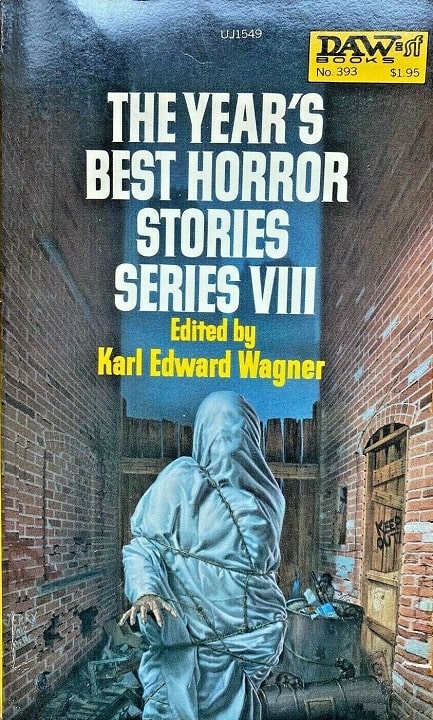 |
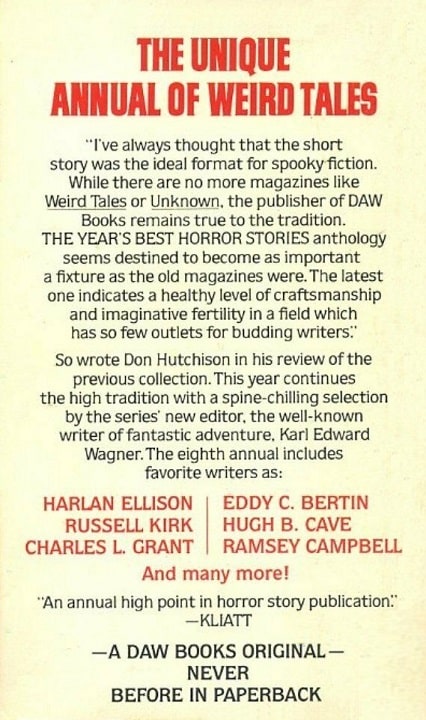 |
The Year’s Best Horror Stories: Series VIII (DAW, July 1980). Cover by Michael Whelan
The Year’s Best Horror Stories: Series VIII was the eighth volume in DAW’s Year’s Best Horror Stories, copyrighted and printed in 1980. This was the first volume edited by horror author and editor Karl Edward Wagner (1945–1994). Artist Michael Whelan (1950–) appears for a sixth time in a row on the cover. I have been very impressed with Whelan’s variety. The covered and walking corpse is a good horrific image for this volume.
All of the authors of The Year’s Best Horror Stories: Series VIII were male. Eleven were American, four were British, one Belgian (Eddy C. Bertin is back). Wagner included four stories from professional magazines, five stories from books (all anthologies), and seven total stories came from professional fanzines, especially Whispers and Midnight Sun. You get the sense that Wagner searched far and wide for horror stories in the most obscure places.
[Click the images for Horrifying versions.]
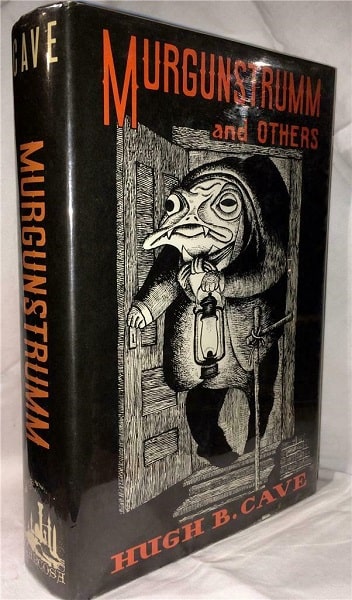 |
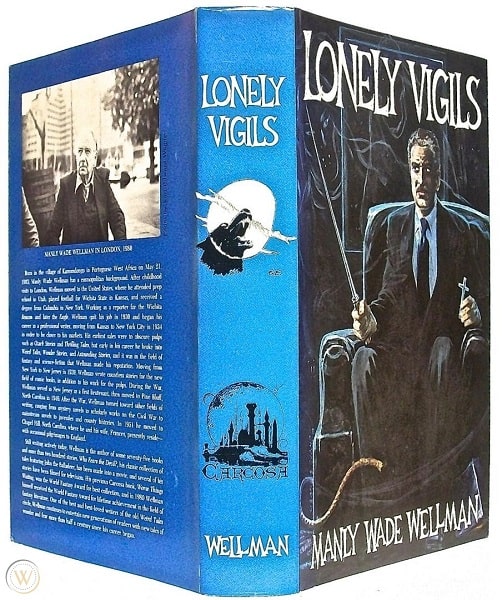 |
Two famous releases by Wagner’s Carcosa Press: Hugh B. Cave’s Murgunstrumm and Others (1977)
and Manly Wade Wellman’s Lonely Vigils (1981). Covers by Lee Brown Coye and George Evans
Professionally, Wagner was at the top of his game in 1980. His Carcosa Press had produced several volumes, and his own sword and sorcery Kane books, also recognized as horror, were selling well. Wagner was widely acknowledged as an expert in the history of the field. Those who knew him regularly comment on his expansive knowledge and his attention to very out-of-the way sources of horror. His brief author bios at the beginning of each story evidence this as well.
Wagner seemed an obvious pick to edit DAW’s Year’s Best Horror Stories. Though the series had gone through two editors in its short seven-volume run, Wagner would stay on in this role through to the end of his life and the end of the series (Volume Twenty-two in 1994).
Wagner dedicated The Year’s Best Horror Stories: Series VIII to former editor Gerald W. Page saying, “Who decided to strap on his guns again, and left a tough act to follow” (p. 8), which also explains why Page was no longer editor. We noted the change in flavor of the series when it went from the first British editor, Richard Davis, to the American, Gerald Page. I think we see also see some definite change of focus with Karl Edward Wagner taking the reins.
However, there is also some clear continuity with previous editors, particularly with the number of returning authors, including Dennis Etchison, Ramsey Campbell, Harlan Ellison (twice in this volume!), Russell Kirk, Eddy C. Bertin, and Charles Grant. But there are plenty of new names appearing for the first time in DAW’s Year’s Best.
One clear difference in theme was that many of the stories were more psychological horror than supernatural. For example, Davis Grubb’s “The Baby-Sitter” has no supernatural element, though it was well-written and suspenseful. Given the title, I thought the baby-sitter would end up being a psychopath. But it turned out the children were the true terrors.
Similar was Eddy C. Bertin’s “My Beautiful Darkling,” though it was ambiguous towards the end. Most of the tale seems to portray a mentally disturbed man. But the last couple of pages suggest that the man was actually quite sane. I’ve enjoyed Bertin’s previous stories but this one meandered a bit, spending too much time on the “insane” man’s ramblings, and the ending was not entirely satisfying.
John Tibbetts’ “The Well at the Half Cat” was a supernatural tale about a man buying an old inn and seeking to re-open it. The inn, The Half Cat, seems to be haunted, or at least the well out back is. This was an interesting story, where the ghosts don’t seem to follow any typical tropes, but over all it was not incredibly compelling. Tibbetts’ tale felt more like a psychological horror more than a ghost story.
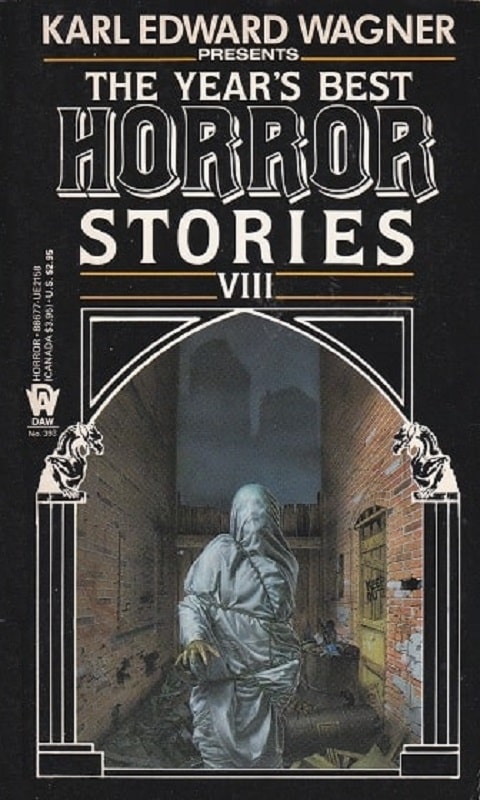 |
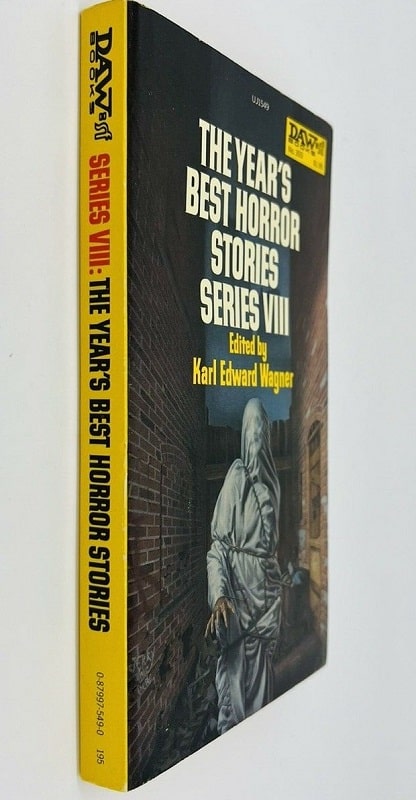 |
1986 paperback reprint (left), and a closer look at that famous DAW yellow spine (right)
I have a soft spot for monster tales. Hugh B. Cave’s “From the Lower Deep” really hit that spot. It follows a man who lives putting about in his little boat on an island close to the mainland, which is experiencing a flood. But something has come with the flood. And the few people who are left on the island are disappearing. This was a creepy but gratifying tale!
One clearly supernatural story was Kevin Lyons’ “Billy Wolfe’s Riding Spirit,” which first appeared in the biker magazine Easyriders. Billy Wolfe is an outlaw biker the law can’t seem to track down. He appears on his chopper on the open highways whenever the full moon hits. But he is always able to mysteriously avoid any roadblocks and getting caught. The narrator, a man who retrieves dead animal carcasses for the state, finds Billy Wolfe’s chopper, rusted and with flat tires. But he also finds Wolfe’s body — which has been dead for months. The story ends with the police radio saying they are again chasing Billy Wolfe. The narrator ends the story with, “It didn’t surprise me at all” (p. 144).
I found Russell Kirk’s “Lex Talionis” to be the gem of this volume. Kirk appeared in Year’s Best Horror VI; that story, though incredibly well-written, was overly maudlin for my taste. But the title of this tale lets you know that sentimentalism will be far from being central here. In my opinion, Kirk writes like an Ernest Hemingway or a Jack London. When you read him, you realize that you are in the throes of a real prose expert. His writing his vivid and moving.
“Lex Talionis” centers on Eddie Mahaffy (also called Eddie Cain), an ex-convict trying to go straight. He seems to be either profoundly religious or a little delusional (perhaps both), but his desire to live a good life seems genuine. Unfortunately, Eddie runs into a fellow nicknamed Butte (like the town in Montana), a fellow convict trying to resume his criminal ways. Butte pressures Eddie into robbing an abandoned mansion, where there is evidently a large sum of money in the cellar. But if it’s abandoned, why does Butte need Eddie?
“What’s to stop you from going there alone? Do you figure there’s something waiting for you in that cellar? Something creepy-crawly?”
“You could scream your head off in the street,” Butte grunted, “an’ the pigs wouldn’t come, not there, not in the middle o’ the night, mebbe not in the daylight.”
Eddie persisted, “Thinking about—ghosts?”
The big man balled his fists. “Shut up!” (p. 158).
Turns out that the mansion is abandoned because the family had been brutalized and murdered and Butte was involved in that revolting crime. In keeping with Eddie’s newfound virtue, he wants nothing to do with this criminal venture. But Eddie seems drawn to go with Butte, as if a voice from heaven is telling him to.
The robbery does not go as Butte had planned. While in the scary old house, before going into the cellar, Eddie seems to change:
“You’re scared of ghosts, buster: well, look at me.”
Some appalling change had come over his appearance, Eddie sensed; but what it was, only Butte’s eyes could see. Butte began to scream at the top of his lungs. Eddie took one more step toward him, and then Butte pitched backward down the long cellar stairs, his heavy body thumping hideously. In the dark at the foot of the stairs, he could not be discerned at all. The screeching had ceased. Eddie closed and bolted the cellar door (pgs. 166–167).
An incredibly unusual but deeply fulfilling horror story!
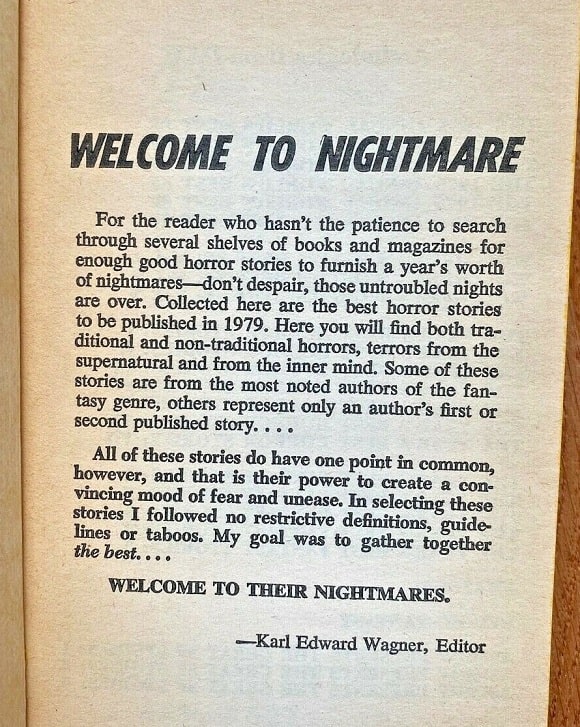 |
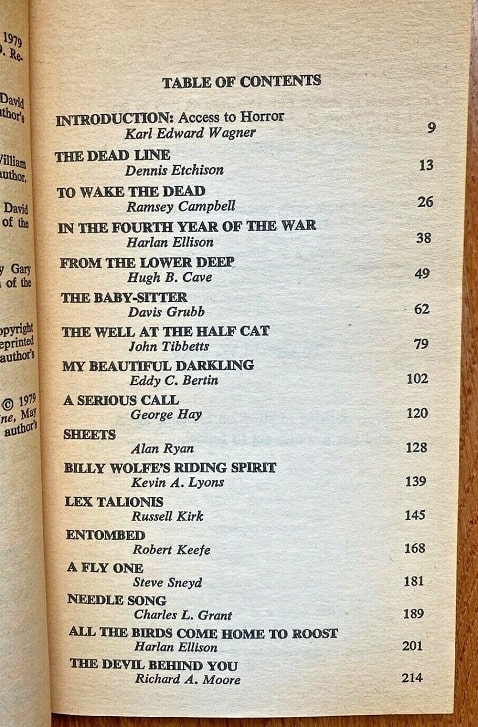 |
Inside cover and Table of Contents of The Year’s Best Horror Stories: Series VIII
Over all, I enjoyed Wagner’s choices for this volume immensely. Most had more of a psychological bent and thus were more naturalistically explainable. Supernatural tales were the exception.
Many of the stories also had a grittier and less playful perspective than earlier DAW volumes. This may reflect more the trajectory of horror at the time than Wagner’s own bias. However, given Wagner’s own tales, I think it might be more the latter. I was incredibly impressed with this volume and look forward to the next DAW’s Year’s Best Horror Stories edited volumes by Wagner.
Here’s the complete Table of Contents for The Year’s Best Horror Stories: Series VIII.
Introduction: Access to Horror, by Karl Edward Wagner
“The Deadline” by Dennis Etchison (Whispers 13–14, 1979)
“To Wake the Dead” by Ramsey Campbell (Dark Horizons 20, 1979)
“In the Fourth Year of the War” by Harlan Ellison (Midnight Sun 5, 1979)
“From the Lower Deep” by Hugh B. Cave (Whispers II, 1979, ed. Stuart Schiff)
“The Baby-Sitter” by Davis Grubb (The Siege of 318: Thirteen Mystical Stories, 1978)
“The Well at the Half Cat” by John Tibbetts (Eldritch Tales 5, 1979)
“My Beautiful Darkling” by Eddy C. Bertin (trans. from Mijn Mooie Duisterlinge, 1979)
“A Serious Call” by George Hay (Ghosts & Scholars, 1979)
“Sheets” by Alan Ryan (Chrysalis 5, 1979)
“Billy Wolfe’s Riding Spirit” (Easyriders, Sept. 1979) by Kevin A. Lyons
“Lex Talionis” by Russell Kirk (Whispers II, 1979, ed. Stuart Schiff)
“Entombed” by Robert Keefe (Gothic 1, 1979)
“A Fly One” by Steven Sneyd (Whispers 13–14, 1979)
“Needle Song” by Charles L. Grant (Midnight Sun 5, 1979)
“All the Birds come Home to Roost” by Harlan Ellison (Playboy, March 1979)
“The Devil Behind You” by Richard A. Moore (Ellery Queen’s Mystery Magazine, May 1979)
Previous installments in this series include:
Introduction To DAW Books’ The Year’s Best Horror Stories (1972–1994)
The Year’s Best Horror Stories: Series I (1972)
The Year’s Best Horror Stories: Series II (1974)
The Year’s Best Horror Stories: Series III (1975)
The Year’s Best Horror Stories: Series IV (1976)
The Year’s Best Horror Stories: Series V (1977)
The Year’s Best Horror Stories: Series VI (1978)
The Year’s Best Horror Stories: Series VII (1979)
Good to see your series back, James! Great job on this installment. I will be looking for the 2 stories “Billy Wolfe’s Riding Spirit” and “Lex Talionis”. Their themes tickled me as they sound like they were inspired by an episode of the old “The Night Stalker” TV series and an Ambrose Bierce tale, respectively.
Thanks John! They’re slowly coming out again. I know I’ve seen that Nightstalker episode but didn’t remember it to make the connection.
I met Kirk in 1985 and interviewed him for a campus newspaper (University of Illinois). He was a delightful interviewee and his remarks, and his comments in some letters, showed him to be knowledgeable about the field of supernatural fiction. If interested in my piece on Kirk and the material I added to it in a small-circulation apazine, get in touch.
Interested. Please email: mcglothlin.13@gmail.com